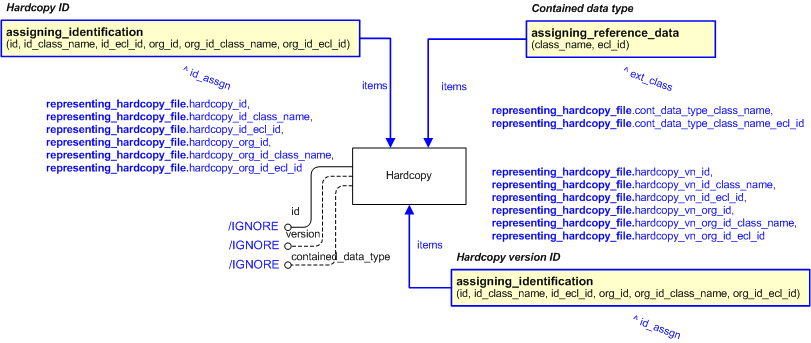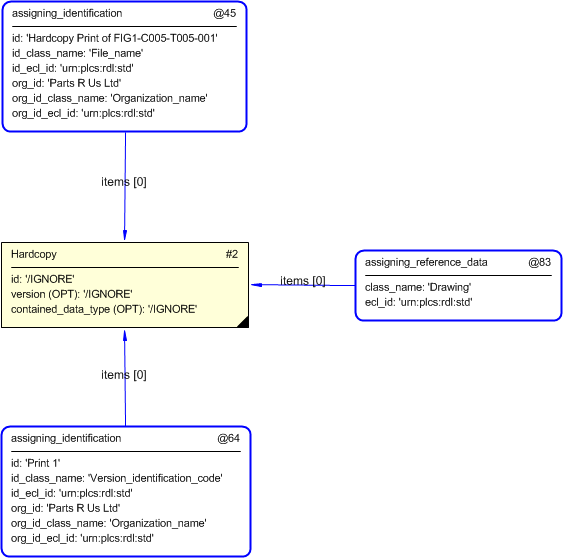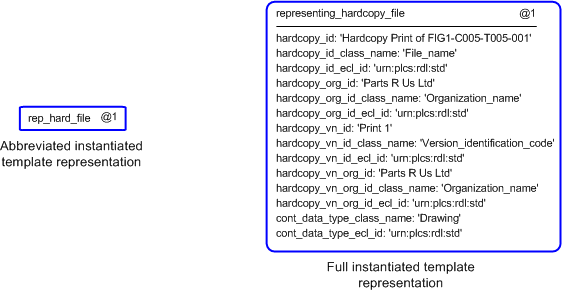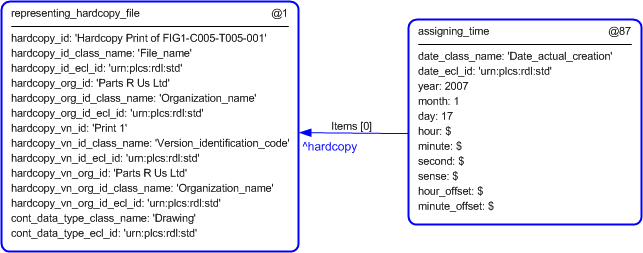Template:— representing_hardcopy_file (rep_hard_file)
Capability:representing_documents |
Date: 2009/03/18 11:50:09
Revision: 1.6
|
This section specifies the template representing_hardcopy_file.
NOTE
The template has been defined in the context of the capability
representing_documents
which provides an overall description of the
relevant parts of the ISO 10303-239 information model and a description
of related templates.
NOTE
An explanation of a template and the associated instantiation path is
provided in the
Template overview
section.
This template describes how to represent a hardcopy file. It does not describe the physical document definition to which a
hardcopy file may belong.
The EXPRESS-G diagram in
Figure
1
shows the templates and EXPRESS entities that are required
to represent the template
"representing_hardcopy_file".
The text highlighted in blue shows the template parameters.
Figure 1 — An EXPRESS-G representation of the Information model for representing_hardcopy_file
The graphic for the template to be used in other EXPRESS-G diagrams
is shown in Figure
2
below.
Figure 2 — The graphical representation of the representing_hardcopy_file template
The following input parameters are defined for this template:
The identifier of the document
The following classes and their sub-classes can be used:
The location of the
External_class_library
that stores the classifications used to classify the document, document_version and document_definition.
The name or identifier of the organization responsible for the document representation
The name of the class being used to classify the identification (
Identification_assignment)
of the organization responsible for creating the document representation
The following classes and their sub-classes can be used:
The identifier of the
External_class_library storing the
definition of the class used to classify the organization identifier.
The version identifier of the document version
The following classes and their sub-classes can be used:
The location of the
External_class_library
that stores the classifications used to classify the document, document_version and document_definition.
The name or identifier of the organization responsible for the document representation
The name of the class being used to classify the identification (
Identification_assignment)
of the organization responsible for the document representation
The following classes and their sub-classes can be used:
The identifier of the
External_class_library storing the
definition of the class used to classify the organization identifier.
The type of data
used to describe the content of the file instance identified.
The following classes and their sub-classes can be used:
classifications: [Contained_data]![[warning:]](../../../../images/dex/warning.gif) Error RDL1: The class Contained_data does not exist in RDL at urn urn:plcs:rdl:std. Check the dexlib/data/refdata/rdl_index.xml[Unknown_data_type]
Error RDL1: The class Contained_data does not exist in RDL at urn urn:plcs:rdl:std. Check the dexlib/data/refdata/rdl_index.xml[Unknown_data_type]![[warning:]](../../../../images/dex/warning.gif) Error RDL1: The class Unknown_data_type does not exist in RDL at urn urn:plcs:rdl:std. Check the dexlib/data/refdata/rdl_index.xml
Error RDL1: The class Unknown_data_type does not exist in RDL at urn urn:plcs:rdl:std. Check the dexlib/data/refdata/rdl_index.xml
The identifier of the
External_class_library storing the
definition of the class used to classify the file identified.
The following reference parameters are defined for this template:
Allow the
Hardcopy
entity instantiated in this path to be referenced when this template is used.
Note: The
Hardcopy
entity can be referenced in a template path by:
%^target = $representing_hardcopy_file.hardcopy%
where
target
is the parameter to which the
Hardcopy
is bound.
The instantiation path shown below specifies the entities that are to be
instantiated by the template.
A description of templates and the syntax for the instantiation path is
provided in the
Templates Help/Information section.
Hardcopy-- Mark the file entity as -- referable when this template is used by binding it to the reference -- parameter id_assgn %^hardcopy =
Hardcopy%
Hardcopy.id = '/IGNORE'
Hardcopy.version = '/IGNORE'
Hardcopy.contained_data_type = '/IGNORE'
-- Identify the Document /
assigning_identification(
items=^hardcopy,
id=@hardcopy_id,
id_class_name=@hardcopy_id_class_name,
id_ecl_id=@hardcopy_id_ecl_id,
org_id=@hardcopy_org_id,
org_id_class_name=@hardcopy_org_id_class_name,
org_id_ecl_id=@hardcopy_org_id_ecl_id )/
-- Note that digital files do not have a digital_file_version - only single atttribute on the file itself. However, we'll
use the same mechanism as previously to identify it. -- Identify the Document_version /
assigning_identification(
items=^hardcopy,
id=@hardcopy_vn_id,
id_class_name=@hardcopy_vn_id_class_name,
id_ecl_id=@hardcopy_vn_id_ecl_id,
org_id=@hardcopy_vn_org_id,
org_id_class_name=@hardcopy_vn_org_id_class_name,
org_id_ecl_id=@hardcopy_vn_org_id_ecl_id )/
-- provide the contained data type of the file by classification /
assigning_reference_data(
items=^hardcopy,
class_name=@cont_data_type_class_name,
ecl_id=@cont_data_type_ecl_id)/
The following entities are instantiated with attributes as specified:
The instance diagram in Figure
3
shows an example of the EXPRESS entities and templates that are instantiated by the template:
/representing_hardcopy_file(hardcopy_id='Hardcopy Print of FIG1-C005-T005-001', hardcopy_id_class_name='File_name', hardcopy_id_ecl_id='urn:plcs:rdl:std', hardcopy_id='Parts R Us Ltd', hardcopy_id_class_name='Organization_name', hardcopy_id_ecl_id='urn:plcs:rdl:std', hardcopy_id='Print 1', hardcopy_id_class_name='Version_identification_code', hardcopy_id_ecl_id='urn:plcs:rdl:std', hardcopy_id='Parts R Us Ltd', hardcopy_id_class_name='Organization_name', hardcopy_id_ecl_id='urn:plcs:rdl:std', hardcopy_id_class_name='Drawing', hardcopy_id_ecl_id='urn:plcs:rdl:std')/
(an illustration of the consolidated representing_hardcopy_file template is shown in
Figure
4 below.)
Figure 3 — Entities instantiated by representing_hardcopy_file template
The instance model in STEP ASCII exchange file format (ISO 10303 Part
21 syntax) is:
DATA;
#15 = EXTERNAL_CLASS('/IGNORE','Organization_name','/IGNORE',#16);
#14 = CLASSIFICATION_ASSIGNMENT(#15,(#12),'/IGNORE');
#12 = IDENTIFICATION_ASSIGNMENT('Parts R Us Ltd','/IGNORE','/IGNORE',(#10));
#10 = ORGANIZATION('/IGNORE','/IGNORE');
#8 = EXTERNAL_CLASS_LIBRARY('urn:plcs:rdl:std',$);
#7 = EXTERNAL_CLASS('/IGNORE','File_name','/IGNORE',#8);
#6 = CLASSIFICATION_ASSIGNMENT(#7,(#4),'/IGNORE');
#4 = IDENTIFICATION_ASSIGNMENT('Hardcopy Print of FIG1-C005-T005-001','/IGNORE',$,(#2));
#2 = HARDCOPY('/IGNORE','/IGNORE','/IGNORE');
#31 = IDENTIFICATION_ASSIGNMENT('Parts R Us Ltd','/IGNORE','/IGNORE',(#29));
#29 = ORGANIZATION('/IGNORE','/IGNORE');
#27 = EXTERNAL_CLASS_LIBRARY('urn:plcs:rdl:std',$);
#26 = EXTERNAL_CLASS('/IGNORE','Version_identification_code','/IGNORE',#27);
#25 = CLASSIFICATION_ASSIGNMENT(#26,(#23),'/IGNORE');
#23 = IDENTIFICATION_ASSIGNMENT('Print 1','/IGNORE',$,(#2));
#21 = EXTERNAL_CLASS_LIBRARY('urn:plcs:rdl:std',$);
#20 = EXTERNAL_CLASS('/IGNORE','Owner_of','/IGNORE',#21);
#19 = CLASSIFICATION_ASSIGNMENT(#20,(#17),'/IGNORE');
#17 = ORGANIZATION_OR_PERSON_IN_ORGANIZATION_ASSIGNMENT(#10,'/IGNORE',(#4));
#16 = EXTERNAL_CLASS_LIBRARY('urn:plcs:rdl:std',$);
#44 = EXTERNAL_CLASS_LIBRARY('urn:plcs:rdl:std',$);
#43 = EXTERNAL_CLASS('/IGNORE','Drawing','/IGNORE',#44);
#42 = CLASSIFICATION_ASSIGNMENT(#43,(#2),'/IGNORE');
#40 = EXTERNAL_CLASS_LIBRARY('urn:plcs:rdl:std',$);
#39 = EXTERNAL_CLASS('/IGNORE','Owner_of','/IGNORE',#40);
#38 = CLASSIFICATION_ASSIGNMENT(#39,(#36),'/IGNORE');
#36 = ORGANIZATION_OR_PERSON_IN_ORGANIZATION_ASSIGNMENT(#29,'/IGNORE',(#23));
#35 = EXTERNAL_CLASS_LIBRARY('urn:plcs:rdl:std',$);
#34 = EXTERNAL_CLASS('/IGNORE','Organization_name','/IGNORE',#35);
#33 = CLASSIFICATION_ASSIGNMENT(#34,(#31),'/IGNORE');
ENDSEC;
The instance model in STEP XML exchange file format (ISO 10303 Part
28 ed.2 syntax) is:
The instance diagram in
Figure
4
shows the graphic symbol for the template that is to be
used in other instance diagrams. The example template is:
/representing_hardcopy_file(hardcopy_id='Hardcopy Print of FIG1-C005-T005-001', hardcopy_id_class_name='File_name', hardcopy_id_ecl_id='urn:plcs:rdl:std', hardcopy_id='Parts R Us Ltd', hardcopy_id_class_name='Organization_name', hardcopy_id_ecl_id='urn:plcs:rdl:std', hardcopy_id='Print 1', hardcopy_id_class_name='Version_identification_code', hardcopy_id_ecl_id='urn:plcs:rdl:std', hardcopy_id='Parts R Us Ltd', hardcopy_id_class_name='Organization_name', hardcopy_id_ecl_id='urn:plcs:rdl:std', hardcopy_id_class_name='Drawing', hardcopy_id_ecl_id='urn:plcs:rdl:std')/
Figure 4 — Entities instantiated by representing_hardcopy_file template
The following section details how the
representing_hardcopy_file
template can be optionally characterized by assigning
other constructs to it. These are characterizations commonly
applied to the template. The ISO 10303-239 EXPRESS model may enable
other assignments to the entities instantiated by the template.
The following characterizations may apply:
Characterization Assigning time
NOTE this characterization is optional.





